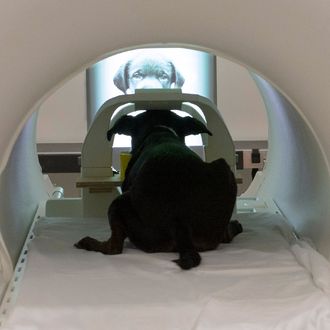
According to new research from psychologists at Emory University’s Dog Project, dogs have a specialized region in their doggy brains specifically for recognizing faces. (Important side note: Apparently Emory University’s psychology department has something called a Dog Project.)
Six dogs, all pets or service dogs on loan from their owners, were specially trained to sit still and gaze at a projection screen while crouched in an fMRI machine, something scientists use to observe a subject’s brain activity by measuring blood flow. From this, the researchers noted that one particular region in the dogs’ temporal lobes responded more strongly to stills or movies of dog and human faces than it did to inanimate objects, like a desk chair. The scientists dubbed this newly discovered area the dog face area (DFA for short), a straightforward kind of name, but one that also nods to the human brain’s fusiform face area (or FFA), the region thought to be responsible for recognizing faces.
In their paper, published online this week in the open-access journal PeerJ, the researchers argue that their findings may help explain dogs’ “exquisite sensitivity to human social cues,” a quality that accounts for that storied BFF-ship long shared between man and canine. But then there are the caveats: For one, six dogs is a very small sample size (for what it’s worth, the researchers started with eight, but only six were well-behaved enough inside the scanner to produce usable results — the other two were bad doggies). For another, dogs aren’t used to looking at two-dimensional images like the ones used in this study, so who knows what they thought they were looking at?
Then again, that picture of a dog in a brain scanner is kind of all I need out of this whole thing. Keep up the good work, Dog Project.




